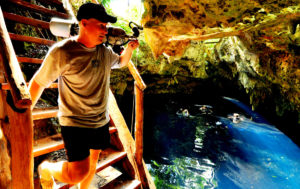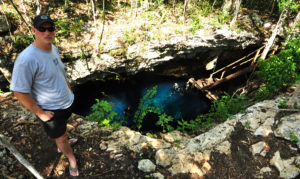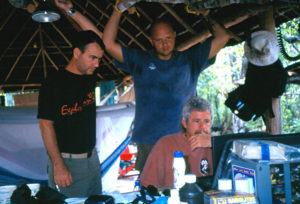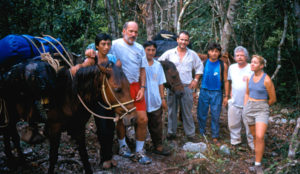Deep Sinkhole photo shoot preparation Part IV (last part)– After unit modification of his AP Diving Evolution CCR Rebreather, Essential prep training and the ccr cave diver course it was time to take the training with my student Paul Nicklen to the next level and ad some Trimix into the equation in order to go deeper vertically into the caves.
As we go diving deeper the partial pressure of nitrogen as well as oxygen go up and become a serious threat to the deep diver in terms of nitrogen narcosis and oxygen toxicity. In order to control these to potential problems the non narcotic gas helium is introduced into the breathing mix. With a variety of formulas or software programs we can determine the partial pressure of oxygen we would like to have as well as the narcotic level we would like to have. Well … none please or not deeper than a 100 feet / 30 meter equivalent for me at least.
There is a variety of Trimix mixtures out there. Notably based on the oxygen content. If you see a Trimix label on a tank it has two numbers i.e. 30/30, 21/35, 14/55 or something similar. The first number is the oxygen content and the second number is the helium content. The balance is nitrogen. The MOD or maximum operational depth of a mix is directly connected to its oxygen content. If we have 30% oxygen in the mix our MOD as of partial pressure of oxygen with no more than 1.6 po2 (or 1.4 TOD target operational depth and working po2) is shallower then it is with 21% oxygen content and that 21% mix is shallower then a mix with 15% oxygen content. As less oxygen in the mix as deeper we can breathe it.
This first step of Trimix diving for Paul is based on Normoxic Trimix. Normoxic because the oxygen level in the mix is on a normal or 21% level as in the air that surrounds us. With the 21% oxygen content we have a MOD at 1.6 po2 of 218 feet / 66 meters.
As we started our training we had to go through some dive planning sessions to expand on the dive planning in terms of decompression stops and bailout gas considerations with hard calculator calculations and tables as well as software programs namely V-Planner. During the ccr cave diver course we have been concerned with mostly one bailout gas but in deep diving operations we have to keep in mind that in case the Rebreather is not functional at depth we still have an alternative path to the surface. Which introduces more bailout tanks into the equation as we need to decompress. In our case we choose to use Ean50 for o/c bailout decompression purposes alone.
As we calculated how much bailout gas we might need from depth all the way up we discussed team versus individual bailout gas strategies with its distinct advantages and disadvantages. As we choose our o/c bottom bailout gas to be a Normoxic Trimix 21/35 and our deco o/c bailout gas Ean50 we determined the volumes needed in order to come back up and with it tank size and amount requirements.
We started then to calculate out onboard diluent requirement which has the distinct need (in my opinion) to have a po2 of 1.0 at max depth. The reason for me is that if I need to make a drastic diluent flush I need to be able to see on my po2 that I am actually doing a successful diluent flush. Meaning if I am diving a 1.2 or 1.3 at the bottom and I do a aggressive diluent flush I need to see the numbers going down to 1.0 po2. That serves me well for sensor verification in case I need to determine which sensor to follow if they all walk out in different directions. In doing my calculations I will have a Trimix mixture in my onboard diluent tank that is not entirely Normoxic anymore. It is still above 16% oxygen content but not at 21% anymore. I am entering a zone where I can’t just breathe on any regulator or BOV anymore without thinking what is connected to it.
At this moment of our training our BOV’s are still connected to our inboard diluent tanks which serves as a step in-between to the large bailout tank which has all the volume to get us back to the surface. I do not consider that adequate and see the potential for sucking out the onboard diluent tank at depth before reaching the large bailout tank and see the need to change the configuration where the BOV accesses the large bottom gas bailout tank directly.
Before we do any deep dives it is back to confined water training to work with our bailout tanks along a cave line to sort out a number of issues including the identification, attaching and gas changes to the proper bailout gas in simulated zero visibility conditions. All went well and easy I have to say largely due to the fact that we just finished the ccr cave diver training program and Paul ze Nicklen was tuned up sharp.
As we started our Trimix deep cave diving we choose “the Pit” as our training grounds mainly due to easy access using the newly installed ladder and platform. We practiced free descends, descending down a line, free floating deco, decompressing on a down line and decompressing circling the walls of the large sinkhole called “ the Pit”. All went well and flawless including bailout ascents from depth into the shallows.
As we spend the days at “the Pit” I could not resist driving down memory lane.
When we did the exploration in 1997 with Mike Madden and Dan Lins being my dive partners (Dan and me found the BMB passage and Bypass Restriction), with Laura and Len Bucko “the bush pilot” our support divers we had to launch all our equipment on horses walk 45 minutes to Nohoch Nachich main entrance, then another 45 minutes to Far Point Station and then another 45 minutes to “the Pit” who has been found during a 5000 + feet exploration cave dive from the Dos Ojos main entrance by Kay Walten and Dan Lins in 1995 or 1996 I believe. Now you just drive right up to it. Clean parking. Gotta watch so you don’t actually drive right into it … would be a nice wreck dive though.
I had a great time spending 14 days diving with Paul ze Nicklen. He turned out to be a competent ccr deep cave diver and I have a lot of respect of what he is doing up in and under the ice, the images he squeezes into his camera.
The ccr unit modification, ccr essential prep program and ccr cave diver program where conducted out of ProTec Playa. The ccr Normoxic Trimix course was conducted out of ProTec Tulum.




